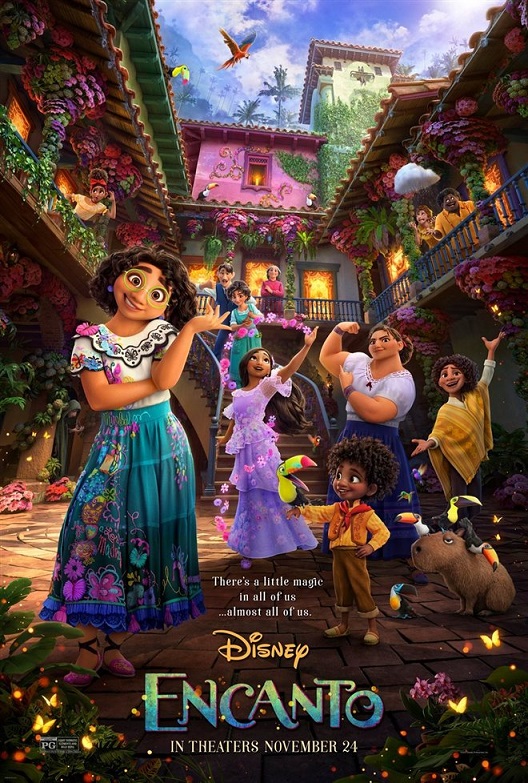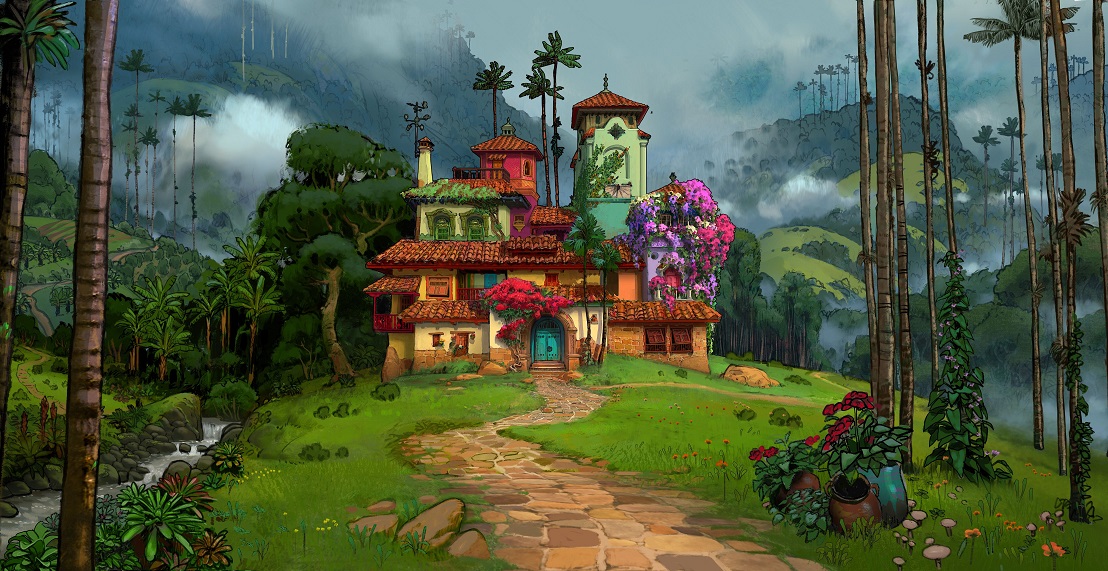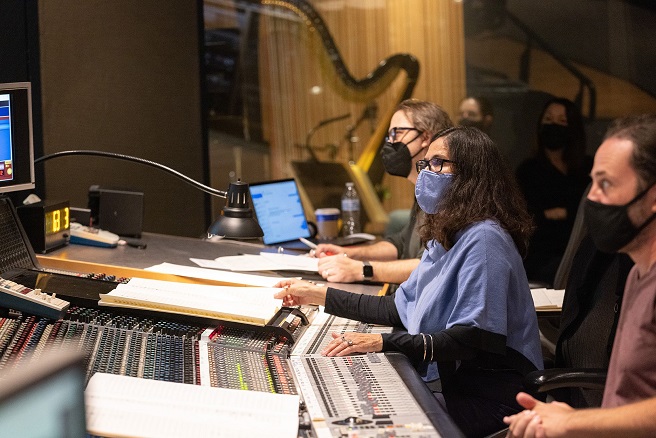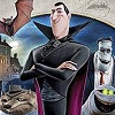 At the Madrigals’, music is definitely part of the family, whether it be the songs, written by multi-talent Lin-Manuel Miranda, or the incomparable score, composed by Germaine Franco, whom we had the pleasure to meet for the occasion of this interview.
At the Madrigals’, music is definitely part of the family, whether it be the songs, written by multi-talent Lin-Manuel Miranda, or the incomparable score, composed by Germaine Franco, whom we had the pleasure to meet for the occasion of this interview.
With Encanto, Germaine will be cemented in history as the first-ever female composer to score a Walt Disney Animation Studios feature film.
Before that, she co-wrote and produced five of Coco’s original songs with co-director Adrian Molina, including “Un Poco Loco” and “Proud Corazón”, and also provided additional music.
Recently, she scored Kung Fu Panda Land Of Awesomeness for Universal Studios Beijing, and completed two feature films for Universal Animation, Curious George: Go West, Go Wild and Curious George: Royal Monkey. She co-wrote and produced the main title theme song for the hit Nickelodeon show The Casagrandes. She also did the music for two of 2019’s six female-composed films: Little and Dora And The Lost City of Gold.
To prepare the score of Encanto, Germaine fully immersed herself in Colombian music, culture, and literature. Her music is a love letter not only to that country and its culture, but also to the characters of the film to whom she felt so connected.
She tells us more about her journey with this very original movie.

Animated Views: As Encanto is set in Colombia, how did you dive into its musical traditions?
Germaine Franco: I got into the film and the music by listening to a lot of Colombian music. Unfortunately, I wasn’t able to go to Colombia because of the pandemic. So, I brought Colombia to me! I listened to thousands of hours of music, from the 1850s all the way to contemporary music. I got into the different genres and all the different regions.
Also, I was able to work with Colombian session musicians who live here in the United States, like Justo Almario, who is a clarinet and sax player, and percussionist J.B. Perez.
I used authentic Colombian instruments, too, like the tiple and the bandola, which are different types of guitars. I literally bought an arpa llanera, a marimba called marimba de chonta, which is a very specific Colombian marimba, and some percussion instruments, tamboras and other hand drums called cununos, and lots of shakers. I had them all shipped to me so that when I recorded, I was using these instruments that have that specific sound from Colombia.
AV: How did all these instruments inspire you?
GF: First, I wrote at the piano, getting all the melodies and themes and motives and harmonies. And then, as I was continuing to write, I was buying those instruments and was inspired by their sound. So, I found the place to use them in the score, seeing what works better for each instrument.
I also developed a lot of textures because there’s this idea of “magical realism” in literature, which is very common in the literature of Gabriel Garcia Marquez and other Colombian writers. It is not specific to Latin American literature, but it is often there. So, the question was – how could we apply that idea to music and sound? A lot of it was kind of having some ambiance sounds. I used some instruments like the harp and the bandola and did a lot of sound effects like tickling the strings a little and having fast and slow tremolos, and then I would layer them with a lot of other instruments in order to develop a texture in certain moments, like when Mirabel walks into Bruno’s tower.

AV: In such a musical film, with so many songs, so many themes, how did you find the score’s own voice, thematically speaking?
GF: That was a very important discussion. When I came in, Lin had already written these fantastic and beautiful songs. So, what we talked about was – we should limit the amount of themes that we tie to each character because if there’s too many, you can’t remember them. So, basically, we decided to make (fewer) themes. One of them was for Mirabel. You can discover it at the beginning, when you first see Abuela speaking to her. It’s very simple, in 3/4. And then, when the brothers and sisters are getting their magic, it starts to expand and becomes the Encanto theme, the overall theme of the casita. It’s not necessarily tied to the house, but it’s kind of the magic of the house. I varied this theme in many different ways. For example, when Abuela is praying, you can hear the Encanto theme very simply on strings. It also comes back many times in different time signatures, harmonized differently. It’s always changing because the house is also always changing, and so is Mirabel.
I used different Colombian rhythms with this theme so that it would change but remain Colombian. For example, when Antonio receives his gift, the idea from Jared and Byron was to make it very Afro-Colombian. They were thinking of the Choco Rainforest with that beautiful imagery of the trees and the animals, and it perfectly went with Afro-Colombian rhythms, one being called “Bullerengue” and the other one “Mapalé”. You still hear the Encanto theme, but it’s done in a completely different way.
Also, in that scene, we actually had a Colombian choir that I was able to add.
You know, Carlos Vives is one of the most amazing singers from Colombia. He’s singing the song “Colombia mi Encanto” in the film and on the record, and I saw his band live at the Hollywood Bowl, which was another way I got into the Colombian sound. I was able to talk to the musicians afterwards, and I invited the accordion player named Christian Camilo Peña to play on the Cumbias. I also wanted the singers. So, we gathered 12 singers after they went back home in Colombia and we did a Skype/Zoom choir session. It took a long time, but it was great. So, we got these incredible Colombian voices on that one particular cue and then also we had the accordionist play on several cues, which is so exciting because he’s got this sound, with his button accordion, which is very different from the keyboard accordion, very different from the Mexican, or French or even Italian accordion. Every country has its own accordion style, and I was happy to be able to get his. He did not read music. So, what we did was – I had the guitarist who played on Coco, named Federico Ramos. He also played the tiple, the mandola and the guitar on Encanto and he would play the melodies, like maybe eight measures, and then Christian would learn it by ear, and then they would go back and forth. And it was worth it because it just sounds so great.
Those experiences working with the musicians and singers were really excellent and so inspirational in terms of interchange of musical ideas.

AV: How did you approach that fantastic Colombian choir?
GF: The choir is a very important part of the thematic phrasing on Encanto. You can hear it first right from the beginning, when the mountains are opening up. To me, the choir always has to be about the feminine voice of Mirabel. I wanted to represent the feminine spirit of the music of Colombia in film. So, I studied this type of singing called “Cantadoras”. They’re descendants of slaves that escaped, and they kept their singing style alive. The women are playing marimbas and percussion and shakers as they’re chanting. When I heard that, I said, “I love these voices. This will really make this scene come alive.” I was gonna try it with the LA session singers, but I didn’t really have anyone that I thought could really do it, because it’s Afro-Latino. So, I thought, as I drove away from the concert by Carlos Vives, let’s get Isa Mosquera, who’s one of his singers. She got twelve singers, and we recorded each voice separately, you know soprano, alto, tenor, bass, so I could really mix it really well, and then, after I edited their part, I added the Los Angeles choir of 22 singers. So, the LA choir had to match the sound of the Colombians, and they did a great job. I worked with Edie Lehmann Boddicker, one of the top vocal conductors and contractors, and she’s singing, too. She’s been on so many of my projects and she really helped me get an amazing sound.
AV: I was really impressed by that very special, magical sound, and it reminded me somehow of the Bulgarian Women’s choir singing in Brother Bear.
GF: I didn’t know that score for Brother Bear, but the funny thing is – it was really difficult to make demos of that sound with the synthesizer and the music library. When I write on my keyboard, I have these different sounds, but that very specific choir sound you can’t recreate unless it’s real people singing. So, when I would make the demos for the directors, I was using the Bulgarian choir sounds to show them what it could sound like! Then I would say, “But it’s gonna be different. I can’t demo this until I actually do it for you live.” And they were really kind enough to believe that I would get that sound, because they didn’t really know what it would sound like ‘til they heard it live. And when Jared and Byron finally listened to the choir live, they loved it. They really let me do my thing on that. I have to say that I just kept working on that one over and over. Every time I would show it to them, I kept changing it. Even after they approved the cue and I had it sent to be orchestrated, I would still be changing it. Even the night before the session. Because I really wanted to keep adding more, because I wanted to make it the best I could.

AV: Colombia is a country of great diversity, which shines through its music, that has so many cultural influences. How did you manage to keep true to that diversity and richness of styles, while keeping a cohesive voice to your score?
GF: Well, I always stuck to the theme, I think that would be the answer. And I also did limit myself to certain types of rhythms. There are so many other Colombian rhythms that are not in the movie. You know, one of the executives on Coco and now President of Walt Disney Music Tom McDougall used to say on Coco ,”This is not a documentary”. So, that would kind of let me have that freedom to pick and choose which rhythm to use.
That was kind of my challenge on this film to figure out how to tell that story musically, be true to the directors’ vision, embrace the Colombian culture and rhythms and still tell a Hollywood story. So, you don’t have to use every single rhythm from every region in Colombia, because we wouldn’t have the time. We’re telling a story and we use the ones that work, like for example the “Joropo”, which is a kind of dance. This whole piece is on the soundtrack. It’s very fast, with lots of triplets. I really wanted to put that in, and I found places that would work. I couldn’t use the entire piece as a whole, so I used sections of it. But the point is, wherever I used this rhythm, I was still sticking to the theme. Even if I changed the harmony, I still had the melodic material. Otherwise, you could go anywhere.
Also, the directors, Jared, Byron and Charise, were very helpful with that, because they were very clear on what they wanted. We had so many discussions and meetings about what the music was supposed to do and what were the characters and their intent. So, I think it wasn’t just me. It was a collaborative process.

AV: What connection did you feel with Mirabel?
GF: I obviously connected with Mirabel because she is very strong-willed and also she never gives up. She keeps going and she’s always on the move trying to figure out how to help her family and how to repair and fix the problems with the house. So, I tried to find a rhythm for her that would always kind of be underlying. I gave her the Cumbia rhythm which is like the national rhythm of Colombia. I personally love Cumbia and the directors do, too. It’s so Colombian. So, I did have that connection, and I basically accompanied her with different elements of Cumbia. Even though when she’s in an action thing, you can still hear it behind.
AV: You not only scored the whole movie, but also participated in the arrangements of the songs.
GF: Most of the songs were already written when I arrived on the movie. Lin would be still changing things here and there, but I was asked to add some orchestra. They were already arranged by Lin and Mike Elizondo with the rhythm section and the vocals. So, what I did was adding orchestral elements sometimes to help make them more cinematic. That was really great to do. And certain songs have more orchestra, like “Waiting On A Miracle” and the last song, “All Of You”. Also, one thing I did was to work on getting from the score into the song. Sometime, I would write a little intro into the song so it sounds like the score is going right into it.
Collaborating with Lin was so exciting because he’s such a wonderful writer and storyteller, musician, composer and singer. He’s got so many ideas and they’re all great. So, basically, I had his demos and Mike would send me his Logic sessions, and then I would put the strings and other orchestral elements on top of that. And we would go back and forth. Then I was able to produce the orchestral sessions for the songs. That was really exciting because the songs sound great without the orchestra, and then the orchestra just gives a little more lift. It was super fun to do.

AV: What does Encanto represent for you as a musician and a composer. What did that experience bring to you in your overall journey as an artist?
GF: Encanto for me represents a turning point in my career as a writer, because I was able to work with such an incredible team of filmmakers and collaborate with Lin. It just really pushed me as a composer. It was definitely a journey as a composer to start with just one scene and then be able to develop the score from the beginning to the end. I had really great support from Disney. To be able to record for almost a month with live musicians, that just doesn’t happen often anymore. Today, so many things are done, as they say, “in the box,” with the composer doing all the parts. You know, I can do that, and I do that. But having all the resources to record an orchestra for two weeks, and a choir in Colombia, and all of these incredible soloists like Pedro Eustache interpret my music is such a highlight in a musical journey. It’s just so gratifying, and I am so grateful.
It represents a point in my work where I’m showing myself what I can do. Especially during the pandemic. While we were recording, we had a covid officer. We couldn’t record the normal way and had to be flexible and figure out how to get it done in the middle of covid. I feel happy that I was given so much support and also was able to finish it in that context.
In the end, I’m so happy with the soundtrack. I love the soundtrack. I love the way the movie came out.
I guess the best part for me was, when the film came out, I went with my mother to see it, and she was so happy. My mom supported me since I was so young. She was watching Encanto, and it kind of blew her away!
The Art of Encanto is available to order from Amazon.com!

The Encanto soundtrack is available to order from Amazon.com!

With our deepest thanks to Germaine Franco, Adrianna Perez and Kyrie Hood at White Bear, and April Whitney at Chronicle Books.






